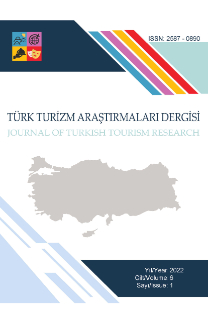En İyiler Sosyal Medyayı Nasıl Kullanıyor: Instagram Örneği
How Do The Best Ones Use Social Media: Example of Instagram
___
- Aktan, E. (2018). Sosyal Medyanın Turizm Pazarlamasındaki Rolünün Değerlendirilmesi, Journal of Tourism and Gastronomy Studies, 6(3):228-248.
- Arat, T. ve Dursun, G. (2016). Seyahat ve Konaklama Tercihi Açısından Sosyal Paylaşım Sitelerinin Kullanımı, Selçuk Üniversitesi Sosyal Bilimler Meslek Yüksekokulu Dergisi, 41.Yıl Özel Sayısı: 111-128.
- Ateş, S., ve Karaduman, İ. (2019). Markanın Sosyal Medyadaki Takipçi Sayısı ve İçerik Miktarının Marka Değerine Etkisi, Stratejik ve Sosyal Araştırmalar Dergisi, 3 (1): 164-179.
- Aydın. B. (2016). Sosyal medyada restoran imajı: Tripadvisor Örneği, Disiplinlerarası Akademik Turizm Dergisi, 1(1): 13-30.
- Bruns, A. and Bahnisch, M., (2009). Social Media: Tools for User Generated Content Social Drivers Behind Growing Consumer Participation in User-Led Content Generation, State of the Art. [Online] https://eprints.qut.edu.au/21206/1/Social_Media_-_State_of_the_Art_-_March_2009.pdf (Erişim Tarihi: 07.11.2020).
- Boyd, D. (2008). American Teen Sociality in Networked Publics. Unpublished Doktoral Thesis, University of Berkeley.
- Camillo, A., Connolly, D. J., and Woo, G. K. (2008). Success and failure in northern Carolina: Critical success factors for independent restaurants. Cornell Hotel and Restaurant Administration Quarterly, 49 (4). 364-380.
- Cankül, D., Metin, M., ve Özvatan, D. (2018). Yiyecek İçecek İşletmeleri ve Sosyal Medya Kullanımı, Journal of Gastronomy, Hospitality and Travel, 1 (1): 29-37.
- Ertopçu, İ. (2019). Restoran İşletmelerinin Sosyal Medya Kullanımı: Instagram Örneği, Güncel Turizm Araştırmaları Dergisi, 3 (1): 49-64
- Eryılmaz, B. ve Zengin, B. (2014). Butik otel işletmelerinin sosyal medya kullanımına yönelik bir inceleme: facebook örneği. Kastamonu Üniversitesi İktisadi ve İdari Bilimler Fakültesi Dergisi, 4(2): 42- 59.
- Güngör, M. Y., Doğan, S., ve Güngör, O. (2016). Yiyecek İçecek Endüstrisi ve Sosyal Medya. O. N. Özdoğan içinde, Yiyecek İçecek Endüstrisinde Trendler I (ss. 129-156). Ankara: Detay
- Güzel, D., Korkmaz, G., ve Yazıcılar F. G. (2018). Sosyal Medyanın Firma Performansı Üzerindeki Etkisi, Atatürk Üniversitesi Sosyal Bilimler Enstitüsü Dergisi, 22 (4): 2237-2247.
- Hajli, M. N. (2014). A study of the impact of social media on consumers. International Journal of Market Research, 56(3): 387-404.
- Hautz, J., Füller, J., Hutter, K., and Thürridl, C. (2013). Let Users Generate Your Video Ads? The Impact of Video Source and Quality on Consumers' Perceptions and Intended Behaviors. Journal of Interactive Marketing, 28: 1-15. https://www.theworlds50best.com/previous-list/2018 (Erişim Tarihi 15.02.2019).
- Kimes, S. E. (2008). The role of technology in restaurant revenue management. Cornell Hospitality Quarterly, 49: 297-308.
- Kumar, V., Bhaskaran, V., Mirchandani, R., and Shah, M. (2013). Practice prize winner-creating a measurable social media marketing strategy: increasing the value and ROI of intangibles and tangibles for hokey pokey. Marketing Science, 32(2): 194-212.
- Kurnaz, A. (2016). Sürdürülebilir Yeşil Restoranlar. O. N. Özdoğan içinde, Yiyecek İçecek Endüstrisinde Trendler II (s. 51-81). Ankara: Detay.
- Kurnaz, A. (2019). Restoran İşletmelerinde Sosyal Medya Kullanımı: Marmaris Örneği. Türk Turizm Araştırmaları Dergisi, 3(4): 1042-1054.
- Ladhari, R., and Michaud, M. (2015). eWOM effects on hotel booking intentions, attitudes, trust, and website perceptions. International Journal of Hospitality Management, 46, 36-45.
- Munar, A. M., and Jacobsen, J. K. S. (2014). Motivations for sharing tourism experiences through social media. Tourism Management, 43: 46-54.
- Narcı, M. T. (2017). Tüketici Davranışları ve Sosyal Medya Pazarlaması: Üniversite Öğrencileri Üzerine Bir Araştırma, Bulletin of Economic Theory and Analysis, 2(3): 279-307.
- Needles, A., and Thompson, G. M. (2013). Social Media Use in the Restaurant Industry: A Work in Progress. Cornell Hospitality Report, 13 (7): 4-16.
- Nisar, T. M., and Whitehead, C. (2016). Brand interactions and social media: Enhancing user loyalty through social networking sites. Computers in Human Behavior, 62, 743-753.
- Öztürk, M., F., ve Talas, M. (2015). Sosyal Medya ve Eğitim Etkileşimi, Journal of World of Turks, 7(1): 101-120.
- Rapp, A., Beitelspacher, L. S., Grewal, D., and Hughes, D. E. (2013). Understanding social mediaeffects across seller, retailer, and consumer interactions. Journal of the Academy of Marketing Science, 41(5): 547-566.
- Roberts, D. L. and Candi, M. (2014). Leveraging social network sites in new product development: Opportunity or hype? Journal of Product Innovation Management: 31(1): 105-117.
- Rosman, R. and Stuhura, K. (2013). The implications of social media on customer relationship management and the hospitality industry. Journal of Management Policy and Practice, 14(3):18-26.
- Şahingöz, S. A. (2018). Sosyal Medya ve Gastronomi. A. Akbaba ve N. Çetinkaya içinde, Gastronomi ve Yiyecek Tarihi (s. 188-210). Ankara: Detay.
- Salleh, S., Hashima, N. H., and Murphy, J. (2015). Instagram marketing: a content analysis of top Malaysian restaurant brands. E-Review of Tourism Research, 6: 1-5.
- Tajvidi, R. and Karami, A. (2017). The effect of social media on firm performance. Computers in Human Behavior. 115(2021): 1-10.
- Terkan, R. (2014). Sosyal Medya ve Pazarlama: Tüketicide Kalite Yansıması, Organizasyon ve Yönetim Bilimleri Dergisi, 6 (1): 57-71.
- Zhang, M., Guo, L., Hu, M., and Liu, W. (2017). Influence of customer engagement with company social networks on stickiness: Mediating effect of customer value creation. International Journal of Information Management, 37(3): 229-240
- ISSN: 2587-0890
- Yayın Aralığı: Yılda 4 Sayı
- Başlangıç: 2017
- Yayıncı: Prof. Dr. Yüksel ÖZTÜRK
Aşçılık Bölümü Tercih Nedenleri ile Kişilik İlişkisi
Turizm ve Festival İlişkisine Yönelik Araştırmaların Bibliyometrik Haritalandırılması (1975-2020)
Termal Turizm İşletmelerinde Sağlık Beklentileri ve Müşteri Memnuniyeti: Bolu Örneği
Hakkı ÇILGINOĞLU, Sercan AYTUĞAR
Gönüllü Turizm Konusunda Yapılan Araştırmaların Bibliyometrik Analizi: Scopus Örneği
Bülent DEMİRAĞ, Sinan ÇAVUŞOĞLU
En İyiler Sosyal Medyayı Nasıl Kullanıyor: Instagram Örneği
Şevki ULEMA, Nazlı KARDEŞ ÇOLAKOĞLU
TripAdvisor Ziyaretçi Yorumlarının İçerik Analizi: Göbeklitepe Örneği
Engin TENGİLİMOĞLU, Ali Rıza MANCI
Osmaniye Mutfak Kültüründe Yer Alan Yemek Ritüelleri Üzerine Bir Araştırma
Türk Mutfağında Füzyon Uygulamalarına Yaklaşım Ölçeğinin Geçerlenmesi
